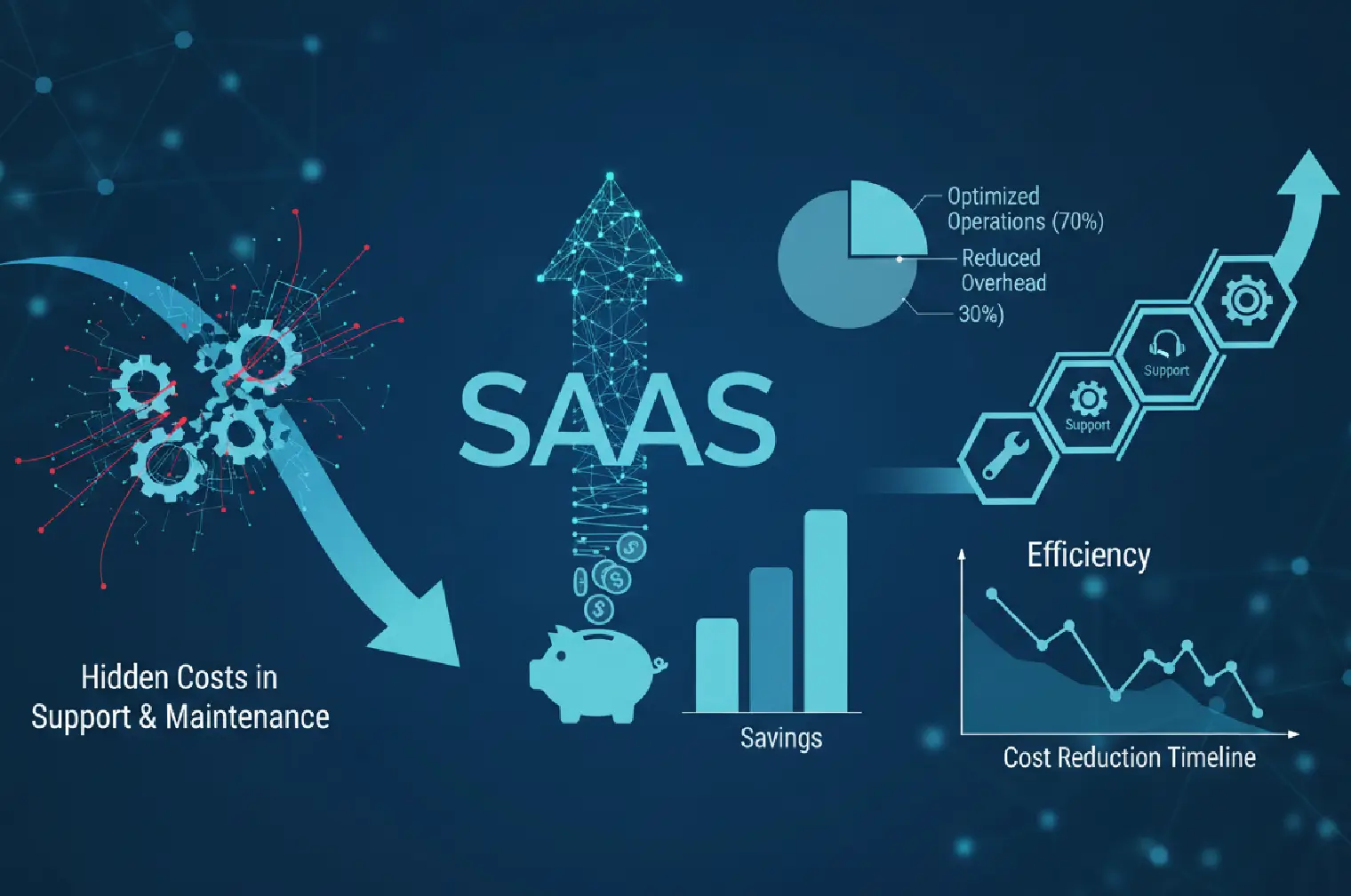Machine Learning and AI for revolution of Tech Companies are changing and streamlining businesses.
Many SMBs and startups begin their digital journey assuming Software as a Service (SaaS) means predictable costs, only to discover that hidden SaaS costs often eat significantly into profitability.
Without strategic oversight and SaaS optimization, the rapid proliferation of SaaS can lead to inefficiencies, redundant subscriptions, and unchecked spending. These financial leaks often stem from avoidable factors like unnecessary subscriptions or inefficient maintenance, making the SaaS product cost-heavy.
Implementing robust strategies ensures that organizations can harness the full potential of their investments.
This guide explores practical SaaS optimization strategies for startups and SMBs:
- Identifying the primary sources of hidden SaaS support and maintenance services costs.
- Actionable techniques to reduce operational waste and reduce hidden SaaS support costs.
- How specialized SaaS product engineering transforms product efficiency and long-term profitability.
What Is SaaS Optimization and Why Does It Matter for SMBs?
SaaS optimization is the strategic, ongoing process of effectively managing software applications to ensure they deliver maximum possible value while minimizing costs and inefficiencies.
It involves assessing current application usage, scrutinizing duplicate tools, licenses, users, and associated spending, and aligning tools with strategic business objectives. While SaaS spend management focuses purely on tracking and controlling costs, SaaS optimization has a broader scope, aiming to maximize benefits such as improved employee productivity and overall business efficiency.
For SMBs, effective SaaS cost optimization is critical because the ease of SaaS acquisition often empowers non-IT personnel to make purchases, leading to significant spend wastage from unused licenses and tool accumulation.
The primary goal is identifying and resolving issues that impact the cost-effectiveness of your application, fostering continual enhancements in cost savings and usage efficiency.
Why Do Hidden Costs in SaaS Support and Maintenance Occur?
Hidden costs in SaaS support and maintenance services arise primarily from organizational complexity and a lack of oversight, a challenge often termed “SaaS sprawl”.
Key cost sinks include:
- Unnecessary Overpayments: Without regular monitoring, unused or underutilized SaaS licenses (often called “shelfware”) remain active, quietly draining financial resources. For example, a department might retain licenses for a project-specific tool long after the project ends, resulting in overpayments.
- Duplication of Services: When departments purchase software independently (Shadow IT), redundant subscriptions with overlapping functionality often go unnoticed, inflating costs unnecessarily and creating administrative complexity.
- Wasted Resources and Inadequate Training: Organizations continue paying for tools that no longer align with organizational goals or are rarely used. Furthermore, inadequate training on tools leads to inefficiency and squandered subscription money because team members may not fully utilize the advanced capabilities they subscribe to.
- Increased Complexity: As portfolios grow, managing multiple vendors, contracts, and renewal timelines becomes increasingly challenging, slowing down procurement processes and reducing efficiency.
These factors require a proactive strategy to reduce hidden SaaS support costs and prevent financial and operational pitfalls.
Check: Building Scalable SaaS Platforms for Retail Startups: A CTO’s Playbook
Reduce Hidden SaaS Support Costs with Smart Optimization
Discover how to cut SaaS support costs for startups with tailored maintenance strategies that streamline operations and maximize ROI.
How Can Startups and SMBs Identify Inefficiencies in Their SaaS Operations?
To implement effective SaaS optimization strategies, startups and SMBs must first gain complete visibility into their spending. Monitoring critical metrics consistently helps pinpoint where spending is inefficient and where optimization efforts should be focused.
Typical red flags and metrics to monitor for inefficiency include:
- License Utilization Rate: This measures the percentage of active licenses compared to the total number purchased. Low rates suggest potential waste and the need for license right-sizing.
- App Overlap: Tracking how many tools perform the same function, such as when two project management tools serve similar purposes, identifies areas for consolidation and leads to immediate cost savings.
- High Cost, Low Usage: Prioritizing optimization efforts on applications that have the highest costs but show the lowest levels of usage yields the most rapid results.
- Churn Rate: This metric indicates the percentage of users who stop using a SaaS application over a specific period; a high churn rate may signal dissatisfaction or that better alternatives are available.
- Untracked Renewals: Tools with impending renewal dates should be prioritized for evaluation, as many SaaS contracts renew automatically, often at higher rates, leading to unexpected price hikes.
- Total Cost of Ownership (TCO): Maintaining a detailed record of all costs associated with each tool (subscription, implementation, support) allows for informed decisions about renewals or cancellations.
What Are the Best SaaS Optimization Strategies for Cutting Hidden Costs?
Implementing the following actionable SaaS optimization strategies is essential to reducing SaaS costs and creating a cost-effective SaaS maintenance plan for SMB:
- Get Complete Spend Visibility: Centralizing all SaaS spend data into a single system allows you to monitor subscriptions, track usage patterns, and perform regular SaaS audits to uncover unused or duplicate software.
- Consolidate Overlapping Apps and Vendors: Merging separate subscriptions for similar services simplifies operations, reduces administrative overhead, and unlocks opportunities for bulk discounts, benefiting from more favorable pricing.
- Reclaim Unused Licenses: Implement license harvesting workflows to continuously monitor usage, identify underutilized licenses, and reallocate them to employees who need access, optimizing resource use without overspending.
- Automate Renewals and Avoid Surprises: Use automation to track renewal deadlines and set up alerts, allowing timely evaluation of the subscription’s necessity, negotiation of better terms, or cancellation before the renewal date, thereby avoiding unwanted costs.
- Negotiate Based on Price Benchmarks: Leverage industry standard pricing insights to secure better deals during contract renegotiations. If a renewal price exceeds the market average, this information can be used as leverage to negotiate a lower rate.
- Focus on Low-Risk Optimization: Cut costs quickly by focusing efforts on optimizing non-production environments using strategies like utilizing spot instances or shutting down setups when nobody is using them.
- Prevent Shadow IT: Use regular audits and establish a clear, straightforward approval process for software purchases to curb unauthorized purchasing and prevent hidden costs and security risks.
Read: Custom AI Solutions in SaaS: Applications, Use Cases, and Trends
How Outsourced SaaS Support & Maintenance Can Improve Cost Efficiency
For lean SMBs and startups, managing a growing, complex SaaS portfolio internally can be time-consuming and challenging. Outsourcing specialized functions like SaaS support and maintenance services is a strategic move to improve cost efficiency and allow internal teams to focus on core innovation.
- Access Expertise and Scale: Developing custom AI solutions or robust integration frameworks requires significant investment in expertise and infrastructure. By partnering with experts, organizations gain immediate access to experienced engineers and proven methodologies without needing to increase headcount.
- Streamlined Operations: Providers, such as ViitorCloud, specialize in SaaS support, maintenance & optimization. This partnership ensures seamless deployment and establishes systems for ongoing monitoring, maintenance, and enhancement of your SaaS product.
- Reduced Risk: Outsourced expertise helps mitigate security and compliance risks that arise from managing numerous unmanaged applications. Specialized providers ensure regular security updates, patches, and adherence to high security and compliance standards, which is a major focus in SaaS application development services.
ViitorCloud delivers customized, scalable solutions, making it a trusted provider of SaaS support for SMBs.
Scale Smarter with Proven SaaS Optimization Strategies
Leverage the best practices for SaaS product engineering for startups and SMBs to scale your support without hiring more agents.
What Role Does Continuous Performance Monitoring Play in Cost Reduction?
Continuous monitoring and performance audits are fundamental elements of modern SaaS maintenance best practices. Relying on static audits is insufficient because the dynamic nature of SaaS requires ongoing vigilance to ensure perpetual optimization.
- Real-time Visibility and Waste Identification: Tools like AI-powered analytics are revolutionizing SaaS optimization by providing real-time visibility into inefficiencies and waste. These tools identify inactive licenses or overlapping apps across teams, offering actionable recommendations for consolidation and contract renegotiation.
- Data-Driven Negotiations: Continuous monitoring of usage patterns generates accurate data on license utilization, feature use, and user activity. This data is crucial for negotiating better contract terms with vendors, ensuring you align spending with actual needs and avoid overpaying for unnecessary capacity.
- Proactive License Management: Monitoring SaaS license utilization helps identify underutilized licenses. This discovery presents a valuable opportunity for reallocation to other employees who need access, effectively uncovering concealed cost-saving opportunities within your organization and ensuring optimal resource allocation.
How to Build a Cost-Effective SaaS Maintenance Plan for Startups and SMBs
Building a cost-effective SaaS maintenance plan for SMBs requires a focus on streamlined processes and automation to achieve scalability without relying on increased headcount.
Key SaaS maintenance strategies for small businesses involve:
- Automation of Routine Tasks: Leveraging technology for tasks like user provisioning, license management, and deprovisioning reduces reliance on time-consuming manual processes. Automated onboarding and offboarding workflows, for instance, save valuable IT time and ensure rapid, secure access revocation.
- Transparent Procurement Guidelines: Establishing clear, documented procurement guidelines prevents decentralized purchasing authority from resulting in overlapping subscriptions and unnecessary spending (SaaS sprawl).
- Leverage License Harvesting: Implementing automated license reclamation workflows is a primary way to scale SaaS support without hiring more agents. These workflows continually monitor usage, identify inactive users, and reallocate licenses, ensuring optimal resource use without manual intervention.
- Prioritize Performance Monitoring: A comprehensive plan must include ongoing performance tracking, reliability checks, and continuous updates. Automated monitoring provides immediate feedback on application performance and security incidents, enabling rapid response and issue resolution without extensive manual oversight.
Check: Why SaaS and Small Businesses Must Embrace Custom AI Solutions
What Are the Best Practices for SaaS Product Engineering and Lifecycle Optimization?
Optimization should be embedded in the product lifecycle from the start, a practice central to SaaS product engineering. Adhering to best practices for SaaS product engineering for startups ensures the foundation is set for sustainable, cost-effective growth.
Key strategies for optimizing the SaaS product development lifecycle for startups:
- Cloud-Native Architectures: Utilizing scalable microservices-based architecture and cloud-native deployment with Continuous Integration/Continuous Deployment (CI/CD) pipelines ensures rapid delivery while maintaining scalability and security throughout the lifecycle.
- Infrastructure-as-Code (IaC): IaC solutions ensure a consistent, secure environment for provisioning, which is vital for managing resources efficiently and avoiding configuration drift.
- Agile and Iterative Development: Following Agile methodologies ensures the product evolves continuously. Iterative enhancement based on user testing and regular demo sessions guarantees that the product adapts to feedback and market changes quickly, reducing the likelihood of costly post-launch modifications.
- AI-First Acceleration: Integrating AI-driven automation at every development stage, from initial code generation to deployment optimization, can achieve a 30-40% reduction in project delivery times and a 50% decrease in manual errors.
As a leading provider of SaaS product engineering services, ViitorCloud helps organizations develop highly scalable, user-centric cloud solutions that transform ambitious business visions into digital realities.
Create an Effective SaaS Maintenance Plan for Your Business
Adopt data-driven SaaS maintenance strategies for small businesses and streamline your SaaS product development lifecycle for sustainable growth.
How Can ViitorCloud Help You Optimize and Scale Your SaaS Product?
True scalability and cost efficiency in your SaaS operations depend on strategic SaaS optimization and robust development practices. By focusing on eliminating waste, centralizing visibility, and prioritizing maintenance from a SaaS product engineering perspective, business owners can significantly cut hidden costs in support & maintenance.
ViitorCloud brings over 14 years of experience delivering exceptional SaaS product engineering services and specialized SaaS Support, Maintenance & Optimization.
Our proven methodologies, which integrate generative AI and cloud services, ensure your organization can achieve up to 40% faster development cycles while maintaining enterprise-grade security standards.
For the Best SaaS product engineering services for startups seeking to manage costs, streamline operations, and scale intelligently, partnering with ViitorCloud is the strategic next step.
Contact ViitorCloud today for a complimentary consultation and discover how our expertise can drive efficiency and sustainable growth for your business.









